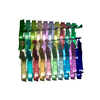+Search query
-Structure paper
| Title | Fibril structures of TFG protein mutants validate the identification of TFG as a disease-related amyloid protein by the IMPAcT method. |
|---|---|
| Journal, issue, pages | PNAS Nexus, Vol. 2, Issue 12, Page pgad402, Year 2023 |
| Publish date | Nov 20, 2023 |
 Authors Authors | Gregory M Rosenberg / Romany Abskharon / David R Boyer / Peng Ge / Michael R Sawaya / David S Eisenberg /  |
| PubMed Abstract | We previously presented a bioinformatic method for identifying diseases that arise from a mutation in a protein's low-complexity domain that drives the protein into pathogenic amyloid fibrils. One ...We previously presented a bioinformatic method for identifying diseases that arise from a mutation in a protein's low-complexity domain that drives the protein into pathogenic amyloid fibrils. One protein so identified was the tropomyosin-receptor kinase-fused gene protein (TRK-fused gene protein or TFG). Mutations in TFG are associated with degenerative neurological conditions. Here, we present experimental evidence that confirms our prediction that these conditions are amyloid-related. We find that the low-complexity domain of TFG containing the disease-related mutations G269V or P285L forms amyloid fibrils, and we determine their structures using cryo-electron microscopy (cryo-EM). These structures are unmistakably amyloid in nature and confirm the propensity of the mutant TFG low-complexity domain to form amyloid fibrils. Also, despite resulting from a pathogenic mutation, the fibril structures bear some similarities to other amyloid structures that are thought to be nonpathogenic and even functional, but there are other factors that support these structures' relevance to disease, including an increased propensity to form amyloid compared with the wild-type sequence, structure-stabilizing influence from the mutant residues themselves, and double-protofilament amyloid cores. Our findings elucidate two potentially disease-relevant structures of a previously unknown amyloid and also show how the structural features of pathogenic amyloid fibrils may not conform to the features commonly associated with pathogenicity. |
 External links External links |  PNAS Nexus / PNAS Nexus /  PubMed:38077690 / PubMed:38077690 /  PubMed Central PubMed Central |
| Methods | EM (helical sym.) |
| Resolution | 2.59 - 2.84 Å |
| Structure data | EMDB-41195, PDB-8teq: EMDB-41198, PDB-8ter: |
| Chemicals |  ChemComp-HOH: |
| Source |
|
 Keywords Keywords | PROTEIN FIBRIL /  amyloid / amyloid /  mutation / mutation /  Charcot-Marie-Tooth disease / Hereditary motor and sensory neuropathy with proximal dominant involvement Charcot-Marie-Tooth disease / Hereditary motor and sensory neuropathy with proximal dominant involvement |
 Movie
Movie Controller
Controller Structure viewers
Structure viewers About Yorodumi Papers
About Yorodumi Papers









